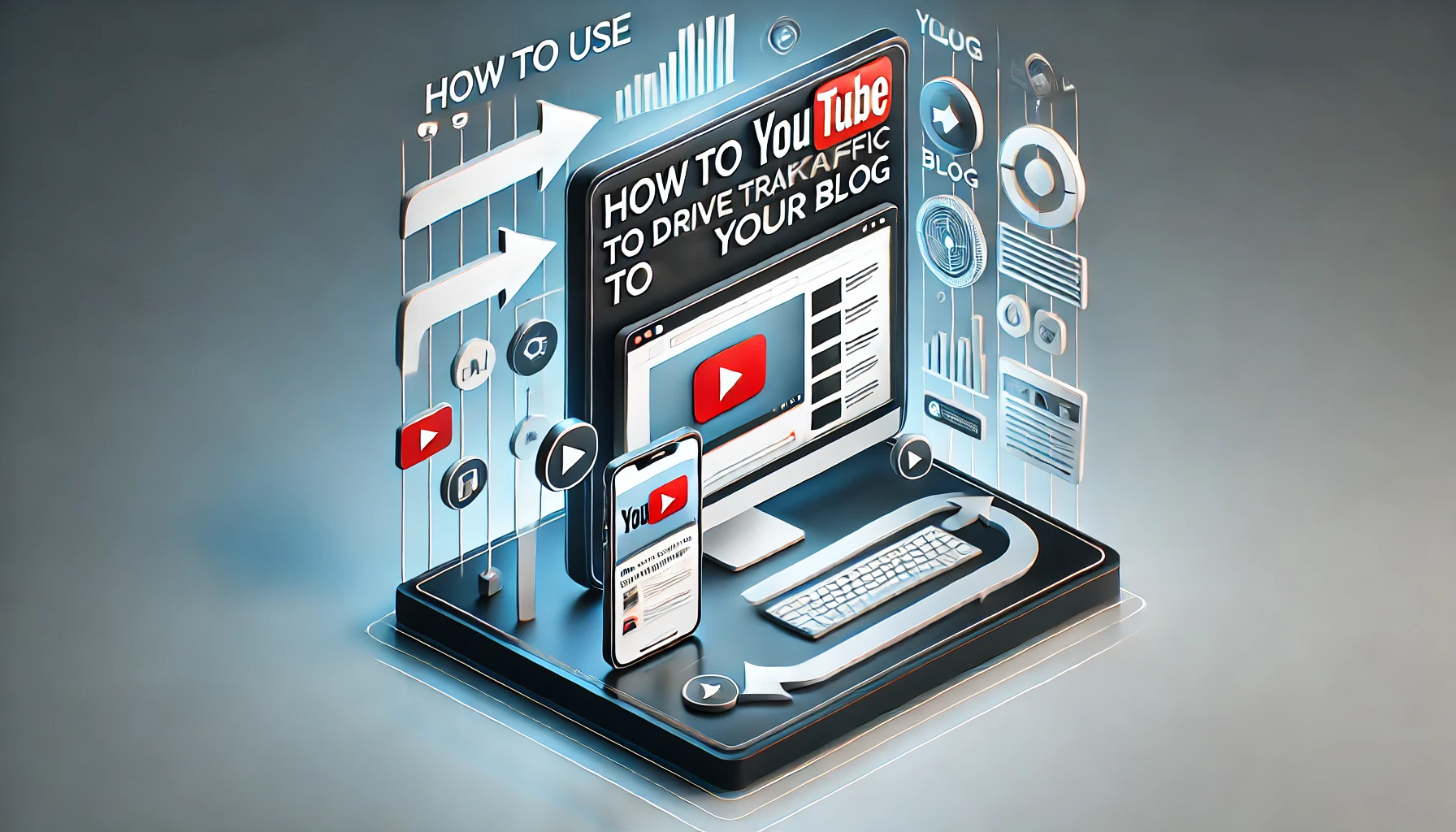In today’s digital age, understanding how to use YouTube to drive traffic to your blog can be a game changer for your online presence.
YouTube, being the second largest search engine globally, offers an incredible platform for content creators, bloggers, and business owners to reach new audiences and push traffic toward their websites.
Whether you’re just starting out or have been blogging for years, leveraging YouTube effectively can significantly boost your blog traffic. In this comprehensive guide, we will address key questions, including how to drive traffic from YouTube to your website, how to generate traffic on YouTube, and practical tips for pushing free traffic to your blog.
Why YouTube Is Key to Driving Blog Traffic
Before diving into specific tactics, let’s explore why YouTube is such a powerful tool for driving traffic to your blog.
- YouTube’s Massive Audience: With over 2 billion monthly active users, YouTube provides access to a global audience. This is an audience that not only consumes video content but also seeks information, tutorials, and entertainment. If your blog aligns with these needs, you have a massive opportunity to funnel traffic from your videos to your website.
- Visual Content Boosts Engagement: Video content is more engaging than text-based content alone. By creating videos that complement your blog, you give your audience a multi-dimensional way to consume information, increasing the chances of them visiting your website for more in-depth content.
- Search Engine Optimization (SEO): Google owns YouTube, which means that having an optimized YouTube channel can boost your search rankings. A well-optimized video with the right keywords can appear in both YouTube and Google search results, leading to a double advantage in driving organic traffic to your blog.
Now, let’s dive deeper into how to drive traffic from YouTube to your website using actionable strategies.
How to Drive Traffic from YouTube to Your Website
If you’re asking, “How do I drive traffic from YouTube to my website?”, the answer lies in strategic planning and execution. Here are several tactics to help you convert YouTube viewers into blog readers:
1. Include Your Blog Links in Video Descriptions
One of the simplest and most effective ways to drive traffic to your blog is by including links to your blog posts in your video descriptions.
Every YouTube video allows space for a description, and this is prime real estate to place a call-to-action (CTA) encouraging viewers to visit your blog. Here’s how to do it effectively:
- Use a clear call-to-action: Don’t just drop the link. Encourage your viewers to visit your blog with specific language like, “For more tips, check out this post on [Your Blog’s URL]” or “Read the full article here.”
- Put the link early: Only the first two or three lines of your video description are visible without viewers having to click “Show more.” Make sure your blog link appears within these first lines.
- Optimize your video description: Include relevant keywords in your description to boost search engine rankings. This helps both your video and blog gain more visibility.
2. Add Your Blog Link in Your YouTube Channel’s About Section
Another often overlooked but highly effective way to drive traffic from YouTube to your blog is by including your blog link in your channel’s “About” section.
This section is an excellent opportunity to introduce new viewers to your content and redirect them to your blog. Ensure your blog link is prominently placed and accompanied by a CTA, such as, “Visit my blog for more in-depth articles and tips.”
3. Use End Screens and Cards to Direct Viewers to Your Blog
YouTube offers two powerful tools to help you push traffic to your blog: end screens and cards.
- End screens: End screens appear in the last 5-20 seconds of your video and can include clickable links to external websites, such as your blog. Make sure to encourage your viewers to click the link before the video ends.
- Cards: Cards are clickable links that appear throughout your video. You can use these to link directly to relevant blog posts related to the content of your video. For example, if your video is about “How to Start a Blog,” you can insert a card linking to a step-by-step guide on your blog.
Both tools provide seamless transitions for viewers, making it easier to direct them to your blog without being overly intrusive.
4. Create Videos That Complement Your Blog Content
A highly effective way to push traffic to your blog is by creating video content that complements your blog posts. Think of each YouTube video as an extension of a blog post.
You don’t have to create entirely new content—simply repurpose your existing blog posts into video format.
Here’s how this strategy works:
Create a blog post summary video: For each new blog post, create a video that summarizes the key points. End the video with a CTA directing viewers to read the full post on your blog.
Tutorial or step-by-step videos: If your blog focuses on how-to guides, creating tutorial videos is an excellent way to provide value to your audience.
Use the video to showcase the steps and direct viewers to your blog for more detailed instructions or downloadable resources.
By pairing video content with blog posts, you not only engage viewers visually but also entice them to explore your blog for more in-depth information.
5. Cross-Promote Your Videos on Social Media and Email Newsletters
Cross-promotion is an effective way to get more views on your YouTube videos and, ultimately, drive more traffic to your blog. Share your YouTube videos on all your social media platforms (Facebook, Instagram, Twitter, LinkedIn) and include them in your email newsletters.
By doing this, you extend the reach of your video content, leading more people back to your blog.

How to Drive Free Traffic to Your Blog Using YouTube
YouTube can be an incredible source of free traffic to your blog, but to make the most of it, you need to apply the right strategies.
Below are some additional ways to drive free traffic to your blog via YouTube:
1. Optimize Your YouTube SEO
SEO (Search Engine Optimization) is just as important for YouTube as it is for traditional search engines like Google. To ensure your videos rank high in search results, focus on these optimization strategies:
Use relevant keywords: Research and use keywords that are popular in your niche. Include these keywords in your video title, description, and tags to help YouTube’s algorithm understand what your video is about.
Create engaging thumbnails: Your video thumbnail is the first thing a potential viewer will see. An eye-catching thumbnail can significantly increase your click-through rate (CTR), leading to more views and potential blog traffic.
Write a compelling video title: Use a title that not only includes your main keyword but also piques curiosity. For example, instead of just “How to Use YouTube to Drive Traffic to Your Blog,” consider a title like “5 Proven Strategies to Drive Massive Blog Traffic from YouTube.”
2. Engage with Your Audience
Engagement is a key factor in the YouTube algorithm. The more your viewers engage with your videos (likes, comments, shares), the more likely YouTube is to recommend your content to others. Here’s how you can boost engagement:
Ask questions: At the end of your video, ask your viewers to share their thoughts in the comments section. This not only boosts engagement but also gives you insights into what your audience wants, helping you create more targeted blog content.
Respond to comments: Building a community on YouTube involves interacting with your audience. Reply to comments on your videos and encourage further discussion.
Create a call-to-action for subscriptions: Ask your viewers to subscribe to your channel for more valuable content. When they subscribe, they’re more likely to see your future videos and visit your blog.
3. Collaborate with Other YouTubers
Collaborating with other YouTubers in your niche is an excellent way to reach a new audience. When you collaborate, you expose your content to their subscribers, who may then check out your blog as well. Here are a few collaboration ideas:
- Guest appearances: Appear on another YouTuber’s channel to discuss a topic related to your blog. Make sure to plug your blog and provide a reason for their audience to visit your website.
- Co-create content: Work with another creator to make a video series or tutorial. Each part can appear on a different channel, driving traffic back and forth between your audiences.
How to Push Traffic to Your Blog Consistently
Consistency is key when it comes to driving traffic to your blog from YouTube. Here’s how to maintain a steady stream of visitors:
1. Stick to a Regular Upload Schedule
YouTube rewards consistency. By posting videos regularly, you keep your audience engaged and coming back for more. Establish a schedule that works for you—whether it’s once a week or twice a month—and stick to it. Consistent uploads not only help grow your YouTube audience but also drive more traffic to your blog over time.
2. Analyze Your Analytics
YouTube provides detailed analytics that show how your videos are performing. Pay attention to metrics like watch time, audience retention, and click-through rates on your blog links. Use this data to refine your content strategy. If a particular video drives more traffic to your blog, consider creating similar videos or expanding on the topic.
3. Continuously Improve Your Content
As with any platform, continuous improvement is essential. Regularly review your video content and update it based on viewer feedback and performance metrics. Experiment with new video formats, styles, and lengths to see what resonates best with your audience.
Conclusion
How to use YouTube to drive traffic to your blog is a question that can be answered with a combination of strategic content creation, SEO optimization, and audience engagement.
By utilizing the tactics discussed in this guide—such as including links in your descriptions, using end screens, optimizing for SEO, and creating content that complements your blog—you can turn YouTube into a powerful driver of free, organic traffic to your website.
Consistency and ongoing analysis are crucial for long-term success. As you refine your strategy, you’ll see YouTube become an integral part of your blog’s growth.
Enjoyed this article? Let’s continue the conversation on LinkedIn.


Hi,
Hey there! Using YouTube to drive traffic to your blog is such a smart move. With over 2 billion monthly active users, it’s like having a massive audience at your fingertips. Plus, video content is super engaging and can really boost your blog’s visibility. I love the idea of including blog links in video descriptions and using end screens and cards to direct viewers to your blog. It’s all about making it easy for your audience to find more of your awesome content. Have you tried any of these strategies yet? If so, which one has worked best for you? If not, which one are you most excited to try out?
-Jay
Hey Jay,
Thanks for the encouragement! I totally agree—YouTube is such a powerful platform for driving traffic. I haven’t fully implemented these strategies yet, but I’m really excited to start using blog links in video descriptions and experimenting with end screens and cards. I think those will be game-changers for getting more eyes on my blog content.
Have you found any specific type of video content or strategy that works particularly well for boosting blog traffic? I’d love to hear your tips!
Cheers,
Herman
This article provides excellent tips on using YouTube to drive traffic to a blog! I especially agree that video content should complement blog posts to maximize results. I’m curious, what types of video topics do you find most effective for encouraging viewers to visit a blog? Personally, I’ve seen great success with tutorials that solve specific problems.
Thank you for sharing your insights! I completely agree that tutorials addressing specific problems can be highly effective in driving blog traffic. In my experience, videos that provide quick tips, behind-the-scenes content, or summaries of in-depth blog posts also tend to pique viewers’ interest and encourage them to explore further. What has been your most successful tutorial topic so far?